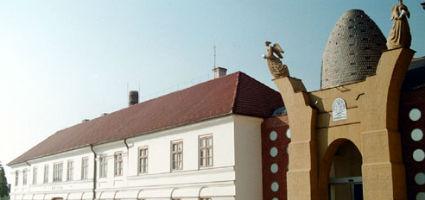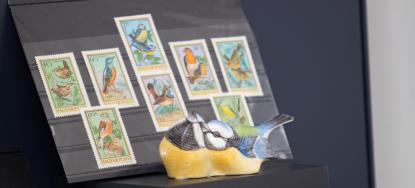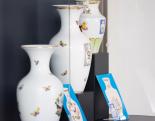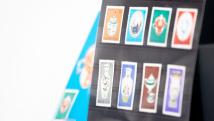2025. December 17. Wednesday
Herend Porcelain Art Museum Foundation - Herend
 |
Address: 8440, Herend Kossuth Lajos utca 140.
Phone number: (88) 523-197, (88) 523-179
E-mail: cassa.muzeum@herend.com
Opening hours: 03.02-11.04.: Tue-Sat 9:30-16:00
14.04-25.10.: Mon-Sun 9:00-17:30 27.10-19.12.: Tue-Sat 9:30-16:00 |
The exhibition has closed for visitors.
Museum tickets, service costs:
|
Ticket for adults
|
500 HUF
|
|
|
Ticket for students
|
200 HUF
|
|
|
Ticket for pensioners
|
400 HUF
|
|
|
Guide
|
1500 HUF
|
|
|
Guide
|
3000 HUF
|
It is safe to say that stamp collecting is one of the most widespread hobbies in the world, and is not even as old as we might first think. Unlike most antique and ancient artefacts, the first postage stamp appeared in England only in 1840 as Penny Black. The stamp depicted Queen Victoria of Britain and, unlike today, had no perforated edges, so it had to be cut to size before use. A parallel can already be drawn here with the Herend Porcelain Manufactory, as the beginning of Herend’s international success can also be traced back to Queen Victoria.

The first stamp collectors appeared in the second half of the 1800s. Later, at the beginning of the 20th century, stamp collecting began to become more widespread, mainly due to the fact that the sales were constantly increasing, so that more and more people had access to stamps. At the same time, they realized that there were more and more old specimens, of which few remained in good condition, so they became more and more valuable and unique and more sought after. The stamp is made of paper and it is easily damaged, so the value of a carefully preserved old stamp can now be almost an astronomical sum. As more and more stamps appeared, more and more people started collecting, and there are now tens of millions of stamp collectors in the world!
With the technical development, the mailing and, unfortunately, the stamps are increasingly being pushed into the background.
In Hungary, during the War of Independence in 1848–49, the newly formed Independent Hungarian Postal Administration began issuing the first Hungarian postage stamp based on the plans of Mór Than, but this failed due to the suppression of the revolution. Only after the Compromise of 1867 could a Hungarian Ministry take over the management of the Hungarian postal affairs again. It was then that the Hungarian Royal Post was established, and domestic stamp issues began slowly. After 1867 and 1871, Hungarian stamps appeared one after the other, first in lithograph form, but from 1874 it was possible to get coloured-numbered krajcár stamps and from 1888 also black-numbered krajcár stamps. From 1900 onwards, the Turul stamps also appeared and were in circulation until 1913. The majority of Hungarian stamp fans started collecting mostly from 1900, which was due to the fact that though hundreds of millions of stamps had been made in the 19th century, only very few of them remained in good condition making them difficult and especially expensive to obtain.
The first Hungarian stamp collecting table societies were established in the 1870s, and then the First Hungarian Association of Letter Stamp Collectors (LEHE) was established in 1884. In 1920, the Stamp Museum opened its doors to systematize and present the stamps issued, and, in accordance with the intentions of the founders, to collect, catalogue, and present all stamps issued by all the countries of the world. This, of course, is no longer achievable these days. Today, the number of stamps in this collection, which is also a curiosity worldwide, is around 13 million. Stamp collecting not only specializes in countries, but stamps are also sorted according to different forms and motifs. Stamp publishers prefer to use custom designs on the stamps including country or age characteristics. Not only stamps but also the various postal devices, letters, envelopes and postmarks associated with them are often very popular among collectors.
The rooms of this exhibition each display a theme presenting stamps related to the theme in association with Herend porcelain items. The themes of the four rooms were jointly worked out by stamp collector László Leitold, Vice President of the National Federation of Hungarian Philatelists, and the Herend Porcelain Museum. Of course, the display of Herend porcelain items on stamps and the porcelain items next to them cannot be missing, giving a special part of the exhibition. Join us to admire the artistic depiction of different themes both on stamps and porcelain items.

The first stamp collectors appeared in the second half of the 1800s. Later, at the beginning of the 20th century, stamp collecting began to become more widespread, mainly due to the fact that the sales were constantly increasing, so that more and more people had access to stamps. At the same time, they realized that there were more and more old specimens, of which few remained in good condition, so they became more and more valuable and unique and more sought after. The stamp is made of paper and it is easily damaged, so the value of a carefully preserved old stamp can now be almost an astronomical sum. As more and more stamps appeared, more and more people started collecting, and there are now tens of millions of stamp collectors in the world!
With the technical development, the mailing and, unfortunately, the stamps are increasingly being pushed into the background.
In Hungary, during the War of Independence in 1848–49, the newly formed Independent Hungarian Postal Administration began issuing the first Hungarian postage stamp based on the plans of Mór Than, but this failed due to the suppression of the revolution. Only after the Compromise of 1867 could a Hungarian Ministry take over the management of the Hungarian postal affairs again. It was then that the Hungarian Royal Post was established, and domestic stamp issues began slowly. After 1867 and 1871, Hungarian stamps appeared one after the other, first in lithograph form, but from 1874 it was possible to get coloured-numbered krajcár stamps and from 1888 also black-numbered krajcár stamps. From 1900 onwards, the Turul stamps also appeared and were in circulation until 1913. The majority of Hungarian stamp fans started collecting mostly from 1900, which was due to the fact that though hundreds of millions of stamps had been made in the 19th century, only very few of them remained in good condition making them difficult and especially expensive to obtain.
The first Hungarian stamp collecting table societies were established in the 1870s, and then the First Hungarian Association of Letter Stamp Collectors (LEHE) was established in 1884. In 1920, the Stamp Museum opened its doors to systematize and present the stamps issued, and, in accordance with the intentions of the founders, to collect, catalogue, and present all stamps issued by all the countries of the world. This, of course, is no longer achievable these days. Today, the number of stamps in this collection, which is also a curiosity worldwide, is around 13 million. Stamp collecting not only specializes in countries, but stamps are also sorted according to different forms and motifs. Stamp publishers prefer to use custom designs on the stamps including country or age characteristics. Not only stamps but also the various postal devices, letters, envelopes and postmarks associated with them are often very popular among collectors.
The rooms of this exhibition each display a theme presenting stamps related to the theme in association with Herend porcelain items. The themes of the four rooms were jointly worked out by stamp collector László Leitold, Vice President of the National Federation of Hungarian Philatelists, and the Herend Porcelain Museum. Of course, the display of Herend porcelain items on stamps and the porcelain items next to them cannot be missing, giving a special part of the exhibition. Join us to admire the artistic depiction of different themes both on stamps and porcelain items.


